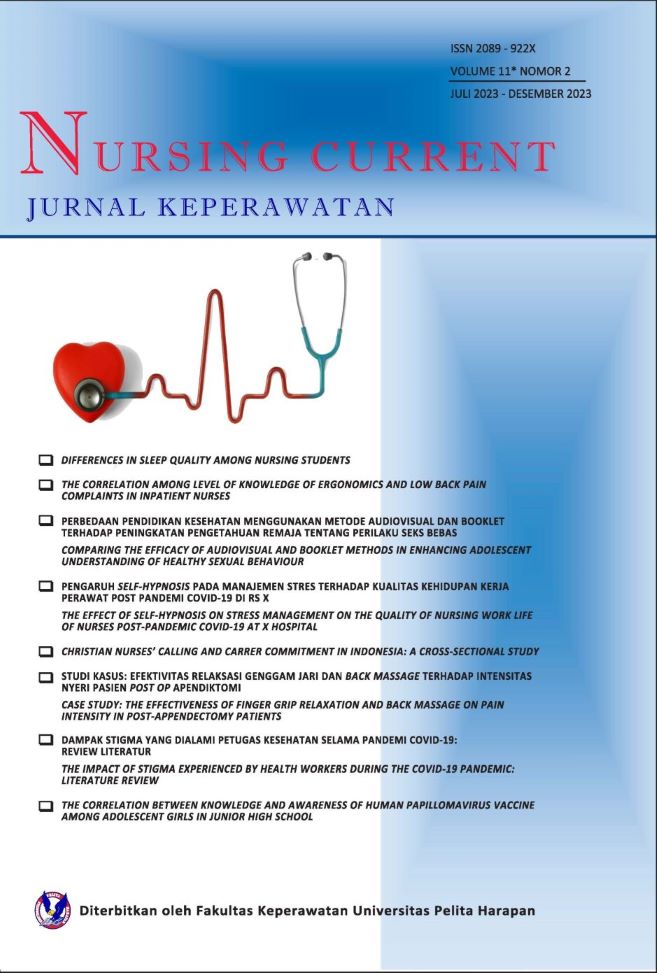DIFFERENCES IN SLEEP QUALITY AMONG NURSING STUDENTS
DOI:
https://doi.org/10.19166/nc.v11i2.7504Keywords:
nursing students, PSQI, sleep qualityAbstract
The sleep quality and academic performance of students are influenced by their activity patterns, which in turn affects their health status. Nevertheless, there is a scarcity of research specifically addressing sleep problems among nursing students. The objective of this study is to identify and analyse the features of nursing students that are associated with variations in their sleep quality. This study employs a correlational descriptive research design, utilising a quantitative technique. A total of 117 individuals were surveyed. The Mann-Whitney and Kruskal-Wallis tests were employed to assess variations in sleep quality according to the attributes of the participants. The findings indicated that a significant majority of participants, up to 87.2%, experienced substandard sleep quality. Based on the subjective evaluation of PSQI components, 50.4% of participants were classified as having good sleep quality. Additionally, 34.2% reported experiencing difficulty falling asleep more than three times a week within 30 minutes. The majority of participants (42.5%) reported a sleep duration of 6-7 hours. Furthermore, 4.3% of participants had taken sleeping pills in the past month. Furthermore, the results demonstrated a strong correlation between the ages of the respondents and their sleep quality (p=0.047). This study uncovers a worrisome pattern indicating that the sleep quality of nursing students is significantly subpar. Hence, it is imperative to employ both academic and non-academic strategies and advancements to enhance the quality of students' sleep.
References
Albqoor, M. A., & Shaheen, A. M. (2021). Prevalence and differences in habitual sleep efficiency, sleep disturbances, and using sleep medication: a national study of university students in Jordan. Sleep and Breathing, 25(2), 1127-1134. https://doi.org/10.1007/s11325-020-02174-2
Araújo, D. de, Soares, C. S., & Almondes, K. M. (2013). Relation between sleep and visuospatial skills in students from a public school. Estudos de Psicologia (Natal), 18(1), 109-116. https://doi.org/10.1590/s1413-294x2013000100018
Arifin, Z., & Wati, E. (2020). Hubungan kualitas Tidur Dengan Konsentrasi belajar Pada Mahasiswa Keperawatan Universitas Muhammadiyah Purwokerto. Human Care Journal, 5(3), 650-660. https://doi.org/10.32883/hcj.v5i3.797
Becker, S. P., Jarrett, M. A., Luebbe, A. M., Garner, A. A., Burns, G. L., & Kofler, M. J. (2018). Sleep in a large, multi-university sample of college students: Sleep problem prevalence, sex differences, and mental health correlates. Sleep Health, 4(2), 174-181. https://doi.org/10.1016/j.sleh.2018.01.001
Belingheri, M., Pellegrini, A., Facchetti, R., De Vito, G., Cesana, G., & Riva, M. A. (2020). Self-reported prevalence of sleep disorders among medical and nursing students. Occupational Medicine, 70(2), 127-130. https://doi.org/10.1093/occmed/kqaa011
Blome, M. J., Johnson, M. L., Jones, M. A., Moore, M. S., & Beck, M. F. (2021). Sleep quality and daytime sleepiness in prelicensure baccalaureate nursing students. Journal of Nursing Education, 60(4), 196-202. https://doi.org/10.3928/01484834-20210322-03
Burns, E. C., Dunn, M. A., Brady, A. M., Starr, B. N., Blosser, G. C., & Garzon, L. D. (2013). Pediatric primary care. Elsevier.
Buysse, D. J., Reynolds, C. F., Monk, T. H., Berman, S. R., & Kupfer, D. J. (1989). The Pittsburgh Sleep Quality Index: A new instrument for psychiatric practice and Research. Psychiatry Research, 28(2), 193-213. https://doi.org/10.1016/0165-1781(89)90047-4
Cox, S. D., Benoit, J. S., Brohard, C. L., & McIntyre, T. M. (2022). Evaluation of sleep quality among nursing faculty: Application of the Pittsburgh Sleep Quality Index””A descriptive correlational study. Nursing Open, 9(1), 339-348. https://doi.org/10.1002/nop2.1067
Fandiani, Y. M., Wantiyah, & Juliningrum, P. P. (2017). Pengaruh Terapi Dzikir Terhadap Kualitas Tidur Mahasiswa Program Studi Ilmu Keperawatan Universitas Jember. NurseLine Journal, 2(1), 52-60. https://repository.unej.ac.id/handle/123456789/81187
Gallego-Gómez, J. I., González-Moro, M. T., González-Moro, J. M., Vera-Catalán, T., Balanza, S., Simonelli-Muñoz, A. J., & Rivera-Caravaca, J. M. (2021). Relationship between sleep habits and academic performance in University Nursing Students. BMC Nursing, 20, 100. https://doi.org/10.1186/s12912-021-00635-x
Hartini, S., Nisa, K., & Herini, E. S. (2021). Faktor-Faktor Yang Berhubungan Dengan masalah tidur remaja selama pandemi Covid-19. Sari Pediatri, 22(5), 311-7. https://doi.org/10.14238/sp22.5.2021.311-7
Hershner, S. D., & Chervin, R. D. (2014). Causes and consequences of sleepiness among college students. Nature and Science of Sleep, 6, 73-84.
https://doi.org/10.2147/NSS.S62907
Hirshkowitz, M., Whiton, K., Albert, S. M., Alessi, C., Bruni, O., DonCarlos, L., Hazen, N., Herman, J., Katz, E. S., Kheirandish-Gozal, L., Neubauer, D. N., O’Donnell, A. E., Ohayon, M., Peever, J., Rawding, R., Sachdeva, R. C., Setters, B., Vitiello, M. V., Ware, J. C., & Adams Hillard, P. J. (2015). National Sleep Foundation’s sleep time duration recommendations: Methodology and results summary. Sleep Health, 1(1), 40-43. https://doi.org/10.1016/j.sleh.2014.12.010
Hysing, M., Harvey, A. G., Linton, S. J., Askeland, K. G., & Sivertsen, B. (2016). Sleep and academic performance in later adolescence: Results from a large population”based study. Journal of Sleep Research, 25(3), 318-324. https://doi.org/10.1111/jsr.12373
James, L., Butterfield, P., & Tuell, E. (2019). Nursing Students’ Sleep Patterns and Perceptions of Safe Practice During Their Entrée to Shift Work. Workplace Health and Safety, 67(11), 547-553. https://doi.org/10.1177/2165079919867714
Leong, R. L. F., Cheng, G. H.-L., Chee, M. W. L., & Lo, J. C. (2019). The effects of sleep on prospective memory: A systematic review and meta-analysis. Sleep Medicine Reviews, 47, 18-27. https://doi.org/10.1016/j.smrv.2019.05.006
Mander, B. A., Winer, J. R., & Walker, M. P. (2017). Sleep and Human Aging HHS Public Access. Neuron, 94(1), 19-36. https://doi.org/10.1016/j.neuron.2017.02.004
Mishra, J., Panigrahi, A., Samanta, P., Dash, K., Mahapatra, P., & Behera, M. R. (2022). Sleep quality and associated factors among undergraduate medical students during COVID-19 confinement. Clinical Epidemiology and Global Health, 15, 101004. https://doi.org/10.1016/j.cegh.2022.101004
Mulyadi, M., Tonapa, S. I., Luneto, S., Lin, W.-T., & Lee, B.-O. (2021). Prevalence of mental health problems and sleep disturbances in nursing students during the COVID-19 pandemic: A systematic review and meta-analysis. Nurse Education in Practice, 57, 103228. https://doi.org/10.1016/j.nepr.2021.103228
Naryati, N., & Ramdhaniyah, R. (2021). Faktor-Faktor Yang Mempengaruhi Kualitas Tidur Mahasiswa Program Studi Sarjana Keperawatan Di Fakultas Ilmu Keperawatan Universitas Muhammadiyah Jakarta Tahun 2021. Jurnal Mitra Kesehatan, 4(1), 5-13. https://doi.org/10.47522/jmk.v4i1.97
National Sleep Foundation. (2020). What Is Sleep Quality? National Sleep Foundation. Retrived from https://www.thensf.org/what-is-sleep-quality/
Nisa, K., Herini, E. S., & Hartini, S. R. I. (2021). Improving adolescent’s knowledge and attitudes regarding sleep through video education. International Journal of Pharmaceutical Research, 13(03), 536-542.
https://doi.org/10.31838/ijpr/2021.13.03.084
Pitaloka, Diah, R., Utami, Tri, G., Novayelinda, & Riri. (2015). Hubungan Kualitas Tidur Dengan Tekanan Darah dan Kemampuan Konsentrasi Belajar Mahasiswa Program Studi Ilmu Keperawatan Universitas Riau. Jurnal Online Mahasiswa, 2(2), 1435-1443. https://jom.unri.ac.id/index.php/JOMPSIK/article/view/8317/7986
Schlarb, A., Friedrich, A., & Claßen, M. (2017). Sleep problems in University Students – an intervention. Neuropsychiatric Disease and Treatment, 13, 1989-2001. https://doi.org/10.2147/ndt.s142067
Setyowati, A., & Chung, M. (2020). Validity and reliability of the Indonesian version of the Pittsburgh Sleep Quality Index in adolescents. International Journal of Nursing Practice, 27(5). https://doi.org/10.1111/ijn.12856
Short, M. A., Bartel, K., & Carskadon, M. A. (2019). Sleep and mental health in children and adolescents. Sleep and Health, 435-445. https://doi.org/10.1016/b978-0-12-815373-4.00032-0
Silva, M., Chaves, C., Duarte, J., Amaral, O., & Ferreira, M. (2016). Sleep quality determinants among nursing students. Procedia - Social and Behavioral Sciences, 217, 999-1007. https://doi.org/10.1016/j.sbspro.2016.02.090
Tahir, M. J., Malik, N. I., Ullah, I., Khan, H. R., Perveen, S., Ramalho, R., Siddiqi, A. R., Waheed, S., Shalaby, M. M., De Berardis, D., Jain, S., Vetrivendan, G. L., Chatterjee, H., Gopar Franco, W. X., Shafiq, M. A., Fatima, N. T., Abeysekera, M., Sayyeda, Q., Shamat, S. F., ”¦ Pakpour, A. H. (2021). Internet addiction and sleep quality among medical students during the COVID-19 pandemic: A multinational cross-sectional survey. PLOS ONE, 16(11). https://doi.org/10.1371/journal.pone.0259594
Tavernier, R., & Willoughby, T. (2014). A longitudinal examination of the bidirectional association between sleep problems and social ties at university: The mediating role of emotion regulation. Journal of Youth and Adolescence, 44(2), 317-330. https://doi.org/10.1007/s10964-014-0107-x
Yilmaz, D., Anrikulu, F., & Dikmen, Y. (2017). Original Paper Research on Sleep Quality and the Factors Affecting the Sleep Quality of the Nursing Students. Current Health Science Journal, 43, 20-24. https://doi.org/10.12865/CHSJ.43.01.03
Downloads
Additional Files
Published
How to Cite
Issue
Section
License
Authors who publish with this journal agree to the following terms:
1) Authors retain copyright and grant the journal right of first publication with the work simultaneously licensed under a Creative Commons Attribution License (CC-BY-SA 4.0) that allows others to share the work with an acknowledgement of the work's authorship and initial publication in this journal.
2) Authors are able to enter into separate, additional contractual arrangements for the non-exclusive distribution of the journal's published version of the work (e.g., post it to an institutional repository or publish it in a book), with an acknowledgement of its initial publication in this journal.
3) Authors are permitted and encouraged to post their work online (e.g., in institutional repositories or on their website). The final published PDF should be used and bibliographic details that credit the publication in this journal should be included.

This work is licensed under a Creative Commons Attribution-ShareAlike 4.0 International License.






